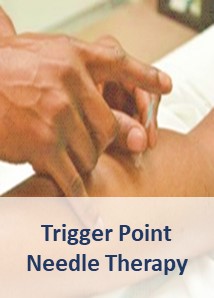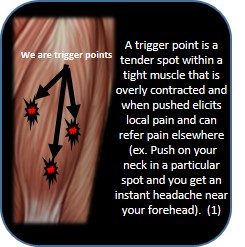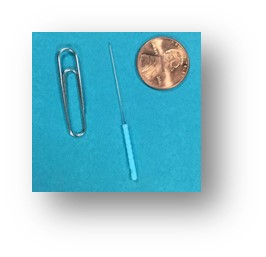Back to all Blogs / Challenges
Tweet

|
 Relieve Your Aches and Pains with Tiny Needles
Relieve Your Aches and Pains with Tiny Needles
Needle. There I said it. Now if you haven’t passed out or clicked away in horror, please read on, this may be a game changer for you...
Indulge me for a second here and close your eyes and think about some muscle/tendon/fascial pain you have, whether it be a brand new injury that hurts a ton (whiplash/muscle spasm/etc), or a more chronic issue that constantly nags you (tennis elbow/shoulder pain/TMJ pain/etc). Think about how many times you have said, “This is just where I hold my tension”, or “man, this one spot is the worst”, or “I wish I could just cut this piece of muscle out of my body”. Believe me, I have heard it all, so I know you all are thinking it. Now, still with your eyes closed, imagine not having that muscle pain. Really try to imagine it. What things could you do again? What would it feel like to get a good night’s sleep? What would it feel like to wake up without feeling like a 90 year old? Felt good didn’t it? For most of us, there are ways to tackle some of these stubborn muscle issues. Unfortunately, we don’t always know what those options are, so today, we are going to discuss trigger point needle therapy, and how it may be the answer to your pain.

Trigger points are created by activities that require repetitive, continuous muscle use (ex. poor posture is notorious for creating trigger points in the upper shoulders and around the shoulder blade) and/or by trauma. See the definition of a trigger point to the right. When present, they prevent full muscle lengthening, thereby limiting range of motion, and weakening the muscle. (1) Trigger points, due to their continued muscle contraction, create an environment of acidity, reduced blood flow, decreased oxygen, and a buildup of inflammatory chemicals.(2) All of that translates to pain and dysfunction for you. Sometimes they can go away on their own over time, but most times they don’t. They can be the unexpected driver of a wide variety of pain and dysfunction in your body because while a trigger point will create pain in it's immediate vicinity, it also refers pain to other areas of the body. That's what makes these guys so tricky, the pain going down your arm could actually be coming from a trigger point underneath your shoulder blade. Luckily, extensive research has been done by Drs. Janet Travell and David Simons to illucidate these referral patterns. To see some of these click here.
Trigger point needle therapy/dry needling is a very effective way to treat those stubborn trigger points. It consists of inserting a thin acupuncture needle (you can fit anywhere from 5-10 acupuncture needles inside the mouth of a typical hypodermic needle used in blood drawing) into the trigger point to release it. This is done until a "local twitch response" is elicited. This is one of the indicators that a trigger point was adequately stimulated and released. There are a variety of needling techniques that your practitioner may use depending on what your symptoms are and where your issue is on your body.
The following can be effectively treated with trigger point needle therapy:
|
Tennis Elbow TMJ Headaches (migraines, tension, etc) Low back pain Neck pain Shoulder pain Carpal Tunnel Whiplash Chronic pain Hip pain Tendonitis/Tendinitis Any many others |

When the needle stimulates a “twitch” in the muscle, it causes it to relax and go back to its resting length, which, in turn, will allow proper blood flow, restore proper pH, and inhibit continuous inflammation. (2) Just inserting the needle into the body can provide enough stimulation to release opioid like chemicals which reduces pain(2).
 Is it safe/will it hurt?
Is it safe/will it hurt?
Trigger point needling is incredibly safe when performed by a trained professional. Because the needle is so thin (see pictures to the left and right for reference) the risks are very low and any discomfort is kept to a minimum. Most people cannot even tell a needle was inserted, but only realize it when the trigger point is reached. At that point, a sore sensation or a quick pinch may be felt. The side effects may include some soreness within the muscle being treated, some slight bruising, or some slight redness around the sight of needle insertion. If you have any fear of needles or have fainted in the past when getting a shot or giving blood, please let your healthcare provider know so that he/she can be adequately prepared and position you accordingly.
Does insurance cover this?
Currently trigger point needle therapy is offered as a cash service in most offices, as most insurance companies have not allowed it as a billable service yet. Because more and more research is showing how effective it can be, it is anticipated that it will become a covered service in the future.
Benefits of Trigger point needle therapy:
- Greater Range of Motion
- Less Pain
- Faster Recovery Time
- Less Stiffness and Tightness
- Better Function/Performance
If you are curious if trigger point needle therapy is right for you, talk to me or a qualified healthcare provider to discuss your case. Trigger point needling is not a magic bullet, but it has been proven to be an emerging therapy that is surpassing some of the traditional ways muscle pain has been treated in the past. So, before you accept that pain is a permanent part of your life, give this a try, it may be just what you need.
1. Bron, Carel, and Jan D. Dommerholt. “Etiology of Myofascial Trigger Points.” Current Pain and Headache Reports 16.5 (2012): 439–444. PMC. Web. 8 June 2017.
2. Osborne NJ, Gatt IT. "Management of shoulder injuries using dry needling in elite volleyball players." Acupuncture in Medicine 2010;28:42-45.
.

